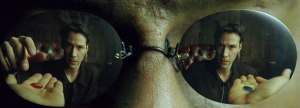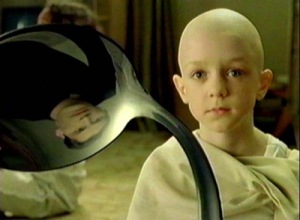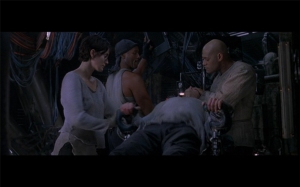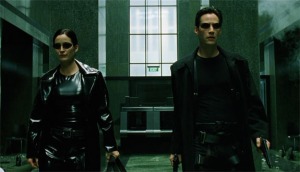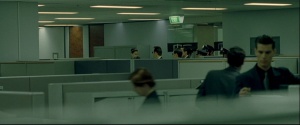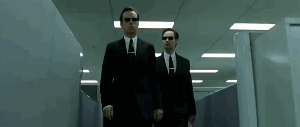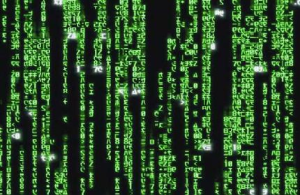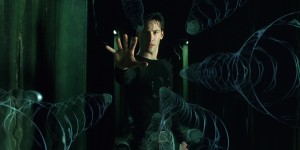The Matrix, written and directed by the Wachowski brothers, created such a world that warranted for sequels, games, more for the audience to explore. This was done by combining certain narrative and visual elements that challenge the audience’s understanding of what is reality and what is the Matrix within the world of this film, which encourages a further investigation of its alternate reality. Starting with one of the most famous scenes, that of Morpheus offering Neo the chance to escape the Matrix and learn the reality of what he is actually living in, or stay in this computer-generated, predetermined world of the Matrix. This scene is loaded with visual and narrative devices that set up this opposition of worlds. Visually, this scene, along with much of the movie, holds an emphasis of screens, mirrors, or reflective surfaces like sunglasses. When Morpheus offers Neo this choice, the red and blue pills are reflected in his sunglasses, alluding to the theme of dual, opposing realities.
For Neo, this is a choice of free will versus fate; it is an abandonment of traditional ideology that our world is one of free will. Of course, he chooses a life of free will, so when he takes the pill and joins reality, there is a moment where he looks at himself in a broken mirror, which he then touches and it begins to overtake him, symbolizing his switch into reality. Neo, along with the audience, begins to discover who he is, what his world is, and what it is not.
Neo again deals with this issue of fate versus free will when Morpheus sends him to an Oracle to “guide” him. Before he he meets with her, Neo meets another prophesied “The One”, a child monk who is mentally bending spoons. Neo tries and fails to bend the spoon, to which the child says that he must think “There is no spoon”. This beat is super important for building the world of the Matrix. It reinforces the idea that nothing is real in the Matrix; it is all computer generated, fabricated, and fixed. When Neo accepts this idea, he realizes that it is not the spoon that must change, it is him. He can control the world of the Matrix by changing himself, knowing what is real and what he is capable of rather than simply believing what he is provided through sensory perception. The audience is discovering the Matrix alongside Neo, so not only is Neo’s world being constantly challenged in what is real and what is fabricated, but the audience is forced to ask these same questions as well.
Once Neo finally meets with the Oracle, she asks Neo if he believes he is “The One” to which he responds no. The Oracle agrees and does not explicitly say whether he is “The One” or not, but she does flirt around the idea, saying that he is waiting for something, but he does have it within him. The exchanges in this scene follow the Oracle in dancing around the idea of Neo’s free will within the Matrix. The Oracle agrees that he is not “The One” because he explicitly says he is not. However, later in the film, Neo faces a choice in which he chooses to believe he is “The One”, and thus becomes it. Although this seems like his choice, this foretelling of fate from the Oracle is reminiscent of another exchange from their first encounter in which the Oracle predicts Neo will break her vase, but only does so as soon as she calls attention to the vase. So the audience, along with Neo, is left wondering can the Oracle determine fate or read the future? Or does she simply guide Neo by planting ideas into his head? This scene is huge in withholding information about the vague laws within the matrix, providing only hints to what is happening, keeping it a mystery to the audience and Neo, even though the Matrix was for a long time, all he knew. It is this reversal of knowledge that builds the audience’s interest in removing the metaphorical blindfold, or in this case, sunglasses.
The visual style of this film is unique in the way it separates its two realities. Obviously the Matrix is set within the green tinted scenes, alluding to it being in a computer screen driven world. The sleek, sexy, cyberpunk outfits with sunglasses that the protagonist and allies wear within the Matrix are also important to the distinctive visual style because of what it adds to not only the more action driven, kung-fu nature of that realm, but it also builds on the narrative idea of the Matrix in that it shows the characters as they want to be seen. Rather than being dressed in rags in the real world, the characters control how they wish to be perceived and essentially get to remake themselves in this computer world, again blurring the lines of what they have control over and what they do not.
Other visual elements that are unique to The Matrix include the recurring image of a grid system, like that of Neo’s workplace in the beginning of the film and the constant grid of numbers on computer screens.
Another, almost revolutionary, visual aspect of the film is the “bullet time” effect of slowing down the action and dollying the camera around a character. This only happens within the world of the Matrix so in a way, it allows the audience to believe they, too, are within the Matrix and are able to cheat natural laws like that of time and space. It truly forces the audience into the space and the world of this film, manipulating conventional ways of watching and perceiving, and blurring lines of reality.
The Matrix was an incredibly significant film within the science fiction genre and managed to create a franchise of sequels, games, comic books, and toys, out of this other world. It is through its narrative design and withholding of explicit explanations of the matrix, as well as its unique visual style that captured its audiences’ imaginations and warranted a billion dollar franchise.
